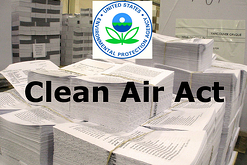 The Environmental Protection Agency (EPA) continues to develop its first greenhouse gas performance standards for both new and existing power plants under the Clean Air Act. These new GHG standards could increase opportunities for both supply- and demand-side advanced energy technologies to the tune of hundreds of billions of dollars, depending on the ultimate regulatory design. This is the latest in a regular series of blog posts chronicling important news about these EPA regulations and their development.
The Environmental Protection Agency (EPA) continues to develop its first greenhouse gas performance standards for both new and existing power plants under the Clean Air Act. These new GHG standards could increase opportunities for both supply- and demand-side advanced energy technologies to the tune of hundreds of billions of dollars, depending on the ultimate regulatory design. This is the latest in a regular series of blog posts chronicling important news about these EPA regulations and their development.
At the EPA, Janet McCabe has been formally nominated as EPA’s new air chief. McCabe has served in this role since Gina McCarthy’s confirmation as EPA administrator. Despite the upcoming battle over greenhouse gas emissions, McCabe’s confirmation should be easier now that Senate rules prevent a filibuster on her nomination. McCabe joined EPA in 2009 after running an Indiana nonprofit on children’s environmental health. Prior to that, she was a professor at the Indiana University School of Medicine’s Department of Public Health, and worked in the Department of Environmental Management.
States are joining forces in response to the upcoming greenhouse gas rules. Fifteen states petitioned the EPA for recognition of their GHG reduction efforts and a power plant emissions reduction cap of more than 17%. The states also requested flexibility in achieving that reduction. “Our state programs are delivering major economic and health benefits by reducing carbon pollution and traditional pollutants while driving investments in energy efficiency and renewable energy,” the letter said. Referring to the President’s commitment to achieve carbon reductions of 17 percent below 2005 levels by 2020, the states noted that “the power sector will have to reduce its emissions more than the overall 17 percent goal because reductions from other sectors (e.g., transportation) will be more difficult to achieve.” These states included California, Colorado, Connecticut, Delaware, Illinois, Maine, Maryland, Massachusetts, Minnesota, New Hampshire, New York, Oregon, Rhode Island, Vermont, and Washington. The letter is found here.
Separately, Attorneys General from 12 states are asking for strong but flexible carbon regulations for existing plants. The AGs argue that “the statute gives EPA and the States sufficient flexibility to achieve meaningful reductions of greenhouse gas emissions quickly and in a cost-effective way.” Represented states include New York, California, Massachusetts, Connecticut, Delaware, Maine, Maryland, New Mexico, Oregon, Rhode Island, Vermont, Washington and the District of Columbia. Their comments are found here.
These and other recommendations for flexible and effective EPA GHG regulations from state officials and regulators are summarized and excerpted in this round-up, with links to comments submitted to the agency.
Michigan is already seeing reactions to the future greenhouse gas rules. In response to EPA’s updated draft regulations for new power plants, the Michigan-based Wolverine Power Cooperative is walking away from its so-called Clean Energy Venture. The project consisted of two coal-fired plants (totaling 600 MW) with no proposed method of capturing carbon emissions and a 35-turbine wind farm. Wolverine CEO Eric Baker said that new greenhouse gas rules from EPA ultimately “render the project impossible to build.” Michigan-based Swan Bay Wind LLC hopes to build a 42-turbine, 140 MW wind farm on that same land.
Legalese for Laypersons – Title V
We continue to provide you with explanations of the legal language around the Clean Air Act as the EPA applies it to power plant greenhouse gas emissions. Today, we look at “Title V.”
Title V of the Clean Air Act concerns operating permits. Title V requires certain existing facilities that emit air pollution to obtain an operating permit, which covers all CAA compliance requirements for that source. The facilities covered by Title V include most large sources (such as power plants) and some smaller sources of air pollution. Title V permits are referred to as “part 70 permits” (if issued by state or local authorities) or “part 71 permits” (if issued by the federal government). Title V permits are reviewed every five years. Title V permits do not cover new stationary sources, or existing sources that undergo major modifications. These two sources fall under a separate permitting process called New Source Review (NSR).
The application of Title V operating permits to GHG emissions will likely take effect in two steps under the Tailoring Rule, which sets GHG thresholds defining when a facility becomes subject to NSR and Title V operating permits. The first phase would not require a source to require a Title V permit solely as a result of GHG emissions with some exceptions. During the second phase, a stationary source would become a major source subject to Title V solely on the basis of their GHG emissions.